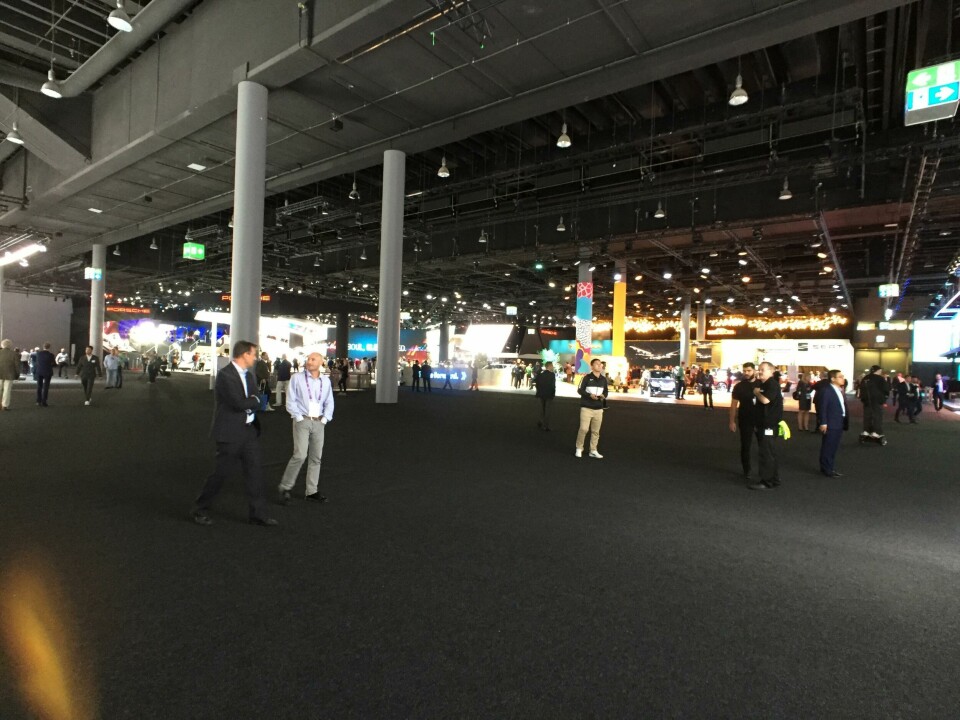
Trend Report: Frankfurt 2019
With the European show season wrapped up for another year, we took a deeper look at what it’s brought us…
While the headlines about IAA 2019 were mostly about climate protests and low attendance, not everything was negative within the halls of the sprawling Frankfurt Messe. There were some major production debuts at the show which made a bigger splash than the concepts and stand designs that we’re used to, and that scaling back and focus on future products really set the tone for the show as a whole.
The German brands made their presence felt in a distinctly lower-key way than in years past, but the decisions to keep the hall assignments the same as in the best days of IAA created a frustrating distance between sparsely-populated halls that symbolised the resistance of the auto industry to move forwards – even in the face of overwhelming evidence that things are changing. Yet signs that the auto industry really is changing (or trying to) were everywhere at IAA, despite first impressions to the contrary.
The most significant sign of movement towards a different future is also the most obvious one: electrification. The arrival of bespoke EV production cars from Volkswagen, Porsche and Honda truly signalled the arrival of a new era. Volkswagen’s ID.3 is the self-proclaimed “next big thing” from the German brand, with a name meant to invoke not only its market segment, but also its place in history as the spiritual successor to the Beetle and Golf. Honda’s E, meanwhile, had already been unveiled in more-or-less production guise in Geneva but was no less impressive on second viewing.
Porsche’s Taycan was the real star however, with the flagship EV from Stuttgart looking far more like the fantastic Mission-E concept than most people expected, with fit and finish that sets a new bar in the EV space.
These three EVs approach their designs very differently, so it will be interesting to watch the reactions they generate. The ID.3 uses undeniably conservative form language, but it’s combined with cab-forward, near one-box proportions that are anything but common – especially in a market where faux premium gaps are becoming more and more usual. On the interior, its brightly coloured, stark and plasticky IP is a huge departure from the dark soft-touch Volkswagen we’ve come to expect. Stepping out of a Golf and into an ID.3 will leave consumers with no doubt that this is something very different.
Step into a Honda E though, it’s hard not to be impressed by the full-width, stepped IP with five integrated screens, including digital dashboard, two touchscreens and rear-view cameras. The E feels somehow more traditional, yet also like a bigger step forward for the Japanese brand than the ID.3 does for Volkswagen. The compact dimensions and retro-futuristic exterior haven’t lost their charm since our first look in Geneva, so it will be interesting to see which approach resonates better with buyers.
On the other end of the EV price spectrum, the Taycan nails classic Porsche proportions in a way that the Panamera has always struggled with. The car’s low centre of gravity is visible in the low roofline and deep-set DLO. On the interior, the ‘all-glass’ user experience – which includes a classically Porsche-shaped digital dashboard, a double-wide infotainment system that stretches all the way to the passenger, and a portrait centre console – will surely appeal to many high-end buyers, but could be a struggle to use at speed compared to a mixed system with some physical controls.
The Porsche and Honda weren’t the only cars to showcase full-width screens, however, as Byton showed a production M-Byte SUV with the concept’s controversial 48-inch display and touchscreen steering wheel intact. Despite sharing a trend which was first seen in Shanghai, comparing the Porsche, Honda and Byton is surprisingly difficult. The three cars approach the challenge of full-width screens in very different ways, with Porsche essentially eliminating all physical controls in favour of touchscreens, Honda using touchscreens mixed with a traditional HVAC system, and Byton mixing two low-set touchscreens, gestures and some interesting physical switches on the steering wheel to control its massive non-touch display.
How these cars are received and how owners perceive their ease or difficulty of use may influence the user interface of many future models, so keep your eyes on all three.
Curiously, as many brands moved further towards wide IP-mounted touchscreen interfaces, Mercedes took their first step away from the layout that they helped popularise over the past few years. The Vision EQS concept is Mercedes’ vision for an electrified S-Class, and its interior was characterised by a huge portrait-oriented centre screen, more like Tesla or Polestar than the horizontal screen we’ve come to expect from the German luxury brand. Whether this is a true move towards better usability or simply playing catchup to the startups isn’t clear, but it will be interesting to see how this new layout looks and functions once it hits production.
In contrast to the production and concept EVs that debuted in Frankfurt, there were also a lot of production debuts that will be much friendlier to automaker balance sheets than to the earth. SUVs continue to be hugely popular with buyers around the world, and IAA showed that while electrification is the big talking point, the reality is that aggressive, high-riding ICE cars are still king. New versions of the BMW X6 and Mercedes GLE are proof that the oft-maligned ‘Coupé SUV’ typology continues to be popular, but more practical SUVs also made an impact.
Mercedes showed the production version of the GLB that was first seen as a lightly-disguised concept in Shanghai, and with it a new breed of premium SUV with seven seats and a more practical shape which comes remarkably close to the now-unloved MPVs that took the world by storm a generation ago.
Another SUV that focused on the ‘utility’ part of the SUV equation was the long-awaited Land Rover Defender. On the exterior, the car is as beautifully surfaced as anything that’s come out of JLR in years, but that perfection also shows that this new Defender is designed to be as much (or more) a car for the posh school run as an expedition through the jungle. While it might be brilliant at both, it many ways the new car simply renders both the Discovery and Discovery Sport less relevant, which perhaps signifies that it’s time for Land Rover to revisit its product lineup.
On the interior, the car is cleverly spartan, with an IP comprised of exposed frame elements holding the digital cluster and infotainment screen, complemented by traditional HVAC controls. How these digital interfaces stand up to rugged use will be a real test, as the centre screen on more than one of the cars on the stand at Frankfurt had already failed just one day into the show. While journalists and benchmarkers can certainly be hard on a car, it’s not difficult to imagine a future of retrofitted analogue gauge clusters and smartphone mounts for the real workhorse Defenders around the world. It would have been nice to see Land Rover come up with an innovative solution to this potential user-experience challenge.
On the other end of the show, the Audi AI:TRAIL showed that wildly futuristic concepts can also be practical. The flight-of-fancy electric autonomous off-roader is perhaps not where you’d expect to find clever real-world solutions, but the Audi actually had several. The car’s pared-back cluster featured an integrated smartphone, much like the Citroën Ami-One shared mobility concept. Meanwhile the rear seats were fixed into place with a pair of ratchet straps – allowing the flexibility to be moved, adjusted or removed quickly and easily. Woven rope grab handles, integrated binoculars and flashlights, and an exposed frunk were also clever touches that showed real thought, while the exterior with its now familiar AI design language, split-glass coach doors and monstrous integrated parametrically-patterned wheel-tyre combinations all seemed to follow standard ‘futuristic’ concept car rules of engagement.
Making a statement in their traditional ‘home’ in Hall 11 (this year shared with other brands for the first time), BMW showed a controversial production preview of the next-generation 4 Series. A static model with no interior, the conversation was literally only skin deep with the Concept 4, but it was hard to ignore how the car seemed to be stepping away from traditional BMW design language. With a huge, vertically oriented, sharp-angled grille and no sign of the round lamps, character line or Hofmeister Kink that have made the Bavarian cars so distinctive since the 1960s, the Concept 4 was jarring in its departure from heritage. Across the hall however, another brand was leaning heavily on its heritage to attempt to reboot its future.
The Hyundai 45 concept was designed to commemorate 45 years since the original ItalDesign Hyundai Pony concept was unveiled. Reframing the old typology as a chunky, high-riding hatchback with pantograph doors was an interesting way to keep the retro design relevant. Also interesting was the stark surfacing and 45-degree angles (get it? 45) that characterised the exterior, as we haven’t seen this design language from the Korean carmaker since its Giugiaro-designed beginnings. This is a departure from recent history, but an intriguing potential jump-off point for the future. On the brightly lit interior, natural materials and softer shapes take centre stage, with a very pared-back IP representing a transitional interior typology as the brand looks towards a self-driving future.
Hyundai’s full-blown vision of a self-driving future was also on display at IAA. Called the H-Space, the pod-like interior buck had no exterior to speak of, but showed a thoughtful approach to future shared autonomous vehicles, with three different interior configurations including a two-seat lounge, a sideways sofa commuter, and a four-seat ‘family’ configuration with removable lightweight seats that can be used for picnics or recreation – much like the original 2CV. The transparent OLED windows of the pod allow passengers to choose between experiencing the real world, an augmented version of the real world with visual overlays, or a particular mood or theme that fits their needs.
The lack of focus on entertainment, social media or individual distraction was a refreshing take on the AV theme, and the brand’s attention to new materials, colours and patterns showed a confidence and playfulness that we haven’t seen before from Hyundai, while presenting an interesting challenge to the German establishment that was surely not lost on anyone.

In the end, Frankfurt 2019 will likely be remembered as the end of an era. Over the years, IAA had become a showcase for German confidence and domination, and with this likely the last time we see an auto show of this scale and scope in Europe, it will also symbolise what could have been. Too big to move quickly. Too slow to embrace change. Too confident to see its flaws.
Ultimately, perhaps, IAA Frankfurt was a perfect reflection of the industry it represented, and its failure can give us hope. Hope that the new innovation and changes in attitude we did see on the show floor aren’t too late to save the carmakers themselves from the same fate that ultimately doomed IAA 2019 before it even started: an unwillingness to face the reality of a new world where cars might just not be at the centre anymore.
































































